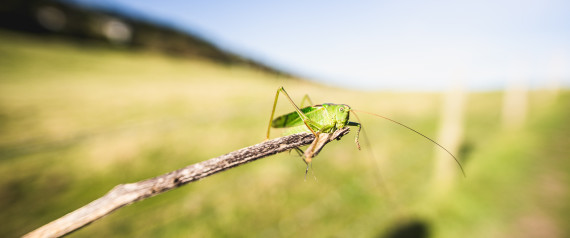In 2012, we rediscovered kale and started nibbling on gluten-free everything. Then 2013 brought us Cronuts, the delicious pastry mashup. We’ve obsessed over Sriracha, pumpkin spice, seaweed — but what will be the next big trend in food?
Bugs! It could be, anyway. Entomophagy, the practice of eating insects, is hailed by entomologists, or people who study them, as a healthy and eco-friendly food solution with a strong culinary tradition (in some cultures). A few high-end restaurants have already put them on the menu. The Michelin-starred Aphrodite restaurant in France, for example, serves up mealworms and crickets with foie gras. British chef Peter Gorton created a menu with entomologist Peter Smithers to feature bugs in every dish.
David Faure, who runs Aphrodite, told Bloomberg the idea to cook with bugs was a product of his world travels. “It’s really a question of taste,” the chef said.
And indeed, it’s no secret that people generally associate bugs with filth and decay — an unappetizing picture. But there are about 1,900 known species of edible insects out there. They’re nutritious, delicious and ripe for the taking. Here’s why it’s time we reconsidered.
1. Bugs are filled with protein.
 Here’s the number one reason to eat bugs: they’re good for you! They’ve got protein, fiber, healthy fats, vitamins and essential minerals. Nutrients differ, of course, by species, age and preparation method, but grasshoppers in particular are packed with about just as much protein as lean ground beef with less fat, and mealworms are typically a fair substitute for fish. Some caterpillars have more protein by weight than a turkey leg — and more fat, too, but it’s a healthier, monosaturated kind.
According to a 2013 report published by the United Nation’s Food and Agriculture Organization, the most popular species of edible insects are, in descending order, beetles, caterpillars, bees, wasps, ants, grasshoppers, locusts and crickets. It’s said that (immature and therefore stingless) bees taste nutty, ants are a bit sweet and grasshoppers just tend to pick up the flavors of cooking spices.
2. They could help solve world hunger.
Here’s the number one reason to eat bugs: they’re good for you! They’ve got protein, fiber, healthy fats, vitamins and essential minerals. Nutrients differ, of course, by species, age and preparation method, but grasshoppers in particular are packed with about just as much protein as lean ground beef with less fat, and mealworms are typically a fair substitute for fish. Some caterpillars have more protein by weight than a turkey leg — and more fat, too, but it’s a healthier, monosaturated kind.
According to a 2013 report published by the United Nation’s Food and Agriculture Organization, the most popular species of edible insects are, in descending order, beetles, caterpillars, bees, wasps, ants, grasshoppers, locusts and crickets. It’s said that (immature and therefore stingless) bees taste nutty, ants are a bit sweet and grasshoppers just tend to pick up the flavors of cooking spices.
2. They could help solve world hunger.
 There’s no denying that population growth will lead to an increased pressure on the food supply. Not only are buggy juices filled with vital nutrients, but unlike traditional livestock, edible insects are also found pretty much everywhere people are living. Combined with the fact that they reproduce quickly and are pretty easy to keep alive, they’ve earned the right to be considered “one of many ways to address food and feed security“ by the U.N. agency.
And loads of people eat them already! Okay, maybe no one you know, but for about two billion people living mostly in Africa, Asia and Latin America, prepared insects are common and well-established part of local diets. Perfectly sane human beings have been toasting grasshoppers for tacos and munching deep-fried worms by the handful for ages, so why can’t you?
Yeah, you might have to get them from a pet supply store for now, unless you live in Africa, Asia or Latin America. But you could be on the forefront of a sweeping new trend!
3. And they don’t use a whole lot of resources.
There’s no denying that population growth will lead to an increased pressure on the food supply. Not only are buggy juices filled with vital nutrients, but unlike traditional livestock, edible insects are also found pretty much everywhere people are living. Combined with the fact that they reproduce quickly and are pretty easy to keep alive, they’ve earned the right to be considered “one of many ways to address food and feed security“ by the U.N. agency.
And loads of people eat them already! Okay, maybe no one you know, but for about two billion people living mostly in Africa, Asia and Latin America, prepared insects are common and well-established part of local diets. Perfectly sane human beings have been toasting grasshoppers for tacos and munching deep-fried worms by the handful for ages, so why can’t you?
Yeah, you might have to get them from a pet supply store for now, unless you live in Africa, Asia or Latin America. But you could be on the forefront of a sweeping new trend!
3. And they don’t use a whole lot of resources.
 Bug farms could be the most efficient animal farms out there. Crickets, for instance, require 12 times less food than cattle and half as much as pigs for the same amount of animal protein, because insects are cold-blooded and more efficient at keeping themselves warm. And the food they do get doesn’t have to be top-notch. Bugs can live on “organic side-streams“ — like food industry byproducts — to help reduce environmental waste. They produce fewer greenhouse gasses, too.
In addition, insects actually like being confined to tiny spaces. Unlike chickens and cows and other animals who would prefer, we assume, being kept on “free-range” farms, bugs don’t mind being cooped up together in one massive cage. If farmed on the same scale, the U.N. report states insects would require “significantly less” water and land resources than traditional livestock.
And while the process of farming insects is decidedly not on the same scale presently — aside from perhaps the fish bait industry, insect harvesting is done mostly on an individual, take-what-you-need sort of basis — U.N. researchers believe it has great potential. If the growing and harvesting process were mechanized, production savings could be passed along to consumers.
4. Eating creepy-crawlies could help curb obesity.
Bug farms could be the most efficient animal farms out there. Crickets, for instance, require 12 times less food than cattle and half as much as pigs for the same amount of animal protein, because insects are cold-blooded and more efficient at keeping themselves warm. And the food they do get doesn’t have to be top-notch. Bugs can live on “organic side-streams“ — like food industry byproducts — to help reduce environmental waste. They produce fewer greenhouse gasses, too.
In addition, insects actually like being confined to tiny spaces. Unlike chickens and cows and other animals who would prefer, we assume, being kept on “free-range” farms, bugs don’t mind being cooped up together in one massive cage. If farmed on the same scale, the U.N. report states insects would require “significantly less” water and land resources than traditional livestock.
And while the process of farming insects is decidedly not on the same scale presently — aside from perhaps the fish bait industry, insect harvesting is done mostly on an individual, take-what-you-need sort of basis — U.N. researchers believe it has great potential. If the growing and harvesting process were mechanized, production savings could be passed along to consumers.
4. Eating creepy-crawlies could help curb obesity.
 No, not because everyone’s lost their appetite. The authors of the U.N. report suggested that because insects contain a comparable amount of protein with more healthy fats than meat, they could help slow down the worldwide obesity epidemic. In 2008, 1.4 billion adults aged 20 and over were overweight, with about 500 million of these being obese, according to the World Health Organization.
The WHO suggests young children in low- and middle-income families are especially susceptible to inadequate nutrition and the health risks that go along with it. (You can totally get more chips for 99 cents than you can kale.) Bugs could be a good solution — they’re cheaper to feed and to produce — if farmed on a large scale.
5. We don’t even have to see them in bug form.
No, not because everyone’s lost their appetite. The authors of the U.N. report suggested that because insects contain a comparable amount of protein with more healthy fats than meat, they could help slow down the worldwide obesity epidemic. In 2008, 1.4 billion adults aged 20 and over were overweight, with about 500 million of these being obese, according to the World Health Organization.
The WHO suggests young children in low- and middle-income families are especially susceptible to inadequate nutrition and the health risks that go along with it. (You can totally get more chips for 99 cents than you can kale.) Bugs could be a good solution — they’re cheaper to feed and to produce — if farmed on a large scale.
5. We don’t even have to see them in bug form.
 We could all just cook with flour made from ground-up creepy-crawlies. A group of MBA students at McGill University was awarded the Hult Prize by former President Bill Clinton last fall to do just that in the world’s poorest urban areas. The group will use local insects — grasshoppers in Mexico, for example, or caterpillars in Botswana — to make nutrient-rich “power flour” for many indigenous people who already eat insects.
The U.N. report suggests mass mechanization of insect farming would facilitate distribution of such processed insects, which Westerners might find just a bit more palatable.
6. Bugs can’t make us sick like meat can.
We could all just cook with flour made from ground-up creepy-crawlies. A group of MBA students at McGill University was awarded the Hult Prize by former President Bill Clinton last fall to do just that in the world’s poorest urban areas. The group will use local insects — grasshoppers in Mexico, for example, or caterpillars in Botswana — to make nutrient-rich “power flour” for many indigenous people who already eat insects.
The U.N. report suggests mass mechanization of insect farming would facilitate distribution of such processed insects, which Westerners might find just a bit more palatable.
6. Bugs can’t make us sick like meat can.
 Edible insects pose a low risk of infecting humans with diseases such as the H1N1 virus and mad cow disease, the U.N. report states. And while salmonella is known to be found in houseflies, not too many people are eating houseflies — willingly, anyway — or even suggesting that they should be on the menu.
A 2005 study on superworms, yellow mealworms, wax moths, butterworms and house crickets concluded it was unlikely that these insects would harbor salmonella or listeria. Like any meat, the U.N. recommends either pasteurization or applying some sort of cooking method to the bugs to kill off any possibly harmful microbes.
Bug-eating could also mean more organically grown produce. The report suggests that if edible insects were collected from agricultural crops, it would negate the need to use so many pesticides.
7. Think bugs are gross? Well it wasn’t that long ago we thought sushi was too.
Edible insects pose a low risk of infecting humans with diseases such as the H1N1 virus and mad cow disease, the U.N. report states. And while salmonella is known to be found in houseflies, not too many people are eating houseflies — willingly, anyway — or even suggesting that they should be on the menu.
A 2005 study on superworms, yellow mealworms, wax moths, butterworms and house crickets concluded it was unlikely that these insects would harbor salmonella or listeria. Like any meat, the U.N. recommends either pasteurization or applying some sort of cooking method to the bugs to kill off any possibly harmful microbes.
Bug-eating could also mean more organically grown produce. The report suggests that if edible insects were collected from agricultural crops, it would negate the need to use so many pesticides.
7. Think bugs are gross? Well it wasn’t that long ago we thought sushi was too.
 Not long ago, few thought that raw fish — handled by gloveless human hands, no less — could appeal to an American palate. A 1981 New York Times editorial, however, argued the prevalence of foreign Japanese eateries in such traditional Anglo-American spheres as the Harvard Club exemplified a growing curiosity of other cultures. Plenty of other cultures eat bugs. Who’s to say that, 30 years from now, people won’t think twice about going out to a trendy bug bar?
San Francisco is on it already — a food cart and catering service called Don Bugito started serving up chocolate-covered salted crickets and mealworm blue-corn tacos. Owner Monica Martinez told the San Francisco Gate she buys her bugs alive so she knows they’re good and fresh, then cleans and cooks them up. A lot of people are grossed out, she says, but most come back for seconds.
“Once you learn about all these amazing things and then at the end you try something that tastes really good, it’s like, why not?”
8. We’re already eating bug parts whether we like it or not.
Not long ago, few thought that raw fish — handled by gloveless human hands, no less — could appeal to an American palate. A 1981 New York Times editorial, however, argued the prevalence of foreign Japanese eateries in such traditional Anglo-American spheres as the Harvard Club exemplified a growing curiosity of other cultures. Plenty of other cultures eat bugs. Who’s to say that, 30 years from now, people won’t think twice about going out to a trendy bug bar?
San Francisco is on it already — a food cart and catering service called Don Bugito started serving up chocolate-covered salted crickets and mealworm blue-corn tacos. Owner Monica Martinez told the San Francisco Gate she buys her bugs alive so she knows they’re good and fresh, then cleans and cooks them up. A lot of people are grossed out, she says, but most come back for seconds.
“Once you learn about all these amazing things and then at the end you try something that tastes really good, it’s like, why not?”
8. We’re already eating bug parts whether we like it or not.
 You all know the drill — chocolate may contain up to 60 insect parts per 100 grams before the FDA considers it defective. Peanut butter may contain up to 30 insect bits per 100 grams. Cinnamon may contain up to 400 parts per 50 grams.
The justification for these regulations? “Aesthetic,” says the FDA. Chances are we’ve all eaten bugs already, and getting an extra tiny shot of protein because of it!
9. If you use their Latin names, bugs sound really fancy.
You all know the drill — chocolate may contain up to 60 insect parts per 100 grams before the FDA considers it defective. Peanut butter may contain up to 30 insect bits per 100 grams. Cinnamon may contain up to 400 parts per 50 grams.
The justification for these regulations? “Aesthetic,” says the FDA. Chances are we’ve all eaten bugs already, and getting an extra tiny shot of protein because of it!
9. If you use their Latin names, bugs sound really fancy.
 Would you care for some toasted Solenopsis accessorized with fried sweetbread? How about seared Tenebrio molitor atop a single kale leaf? That’s ants and beetles for the unacquainted.
In English, we already use foreign names to separate the animal from the food. When the Normans invaded England in 1066, they introduced French to the ruling and upper classes — commoners speaking Old English in the fields raised cows and sheep that turned into beef and veal on well-refined tabletops.
Pass the Gryllidae, please!
TheHuffingtonPost
Would you care for some toasted Solenopsis accessorized with fried sweetbread? How about seared Tenebrio molitor atop a single kale leaf? That’s ants and beetles for the unacquainted.
In English, we already use foreign names to separate the animal from the food. When the Normans invaded England in 1066, they introduced French to the ruling and upper classes — commoners speaking Old English in the fields raised cows and sheep that turned into beef and veal on well-refined tabletops.
Pass the Gryllidae, please!
TheHuffingtonPost










댓글 없음:
댓글 쓰기